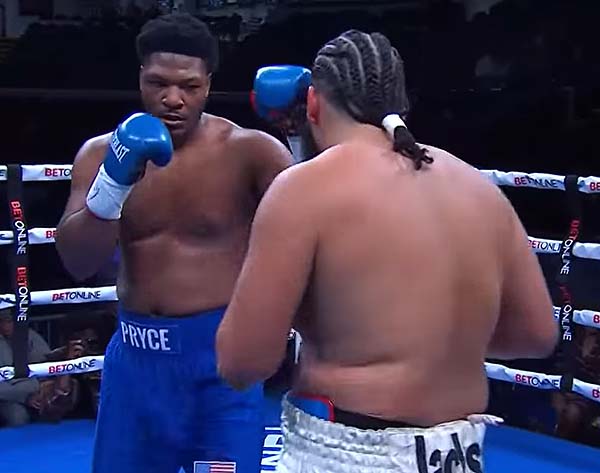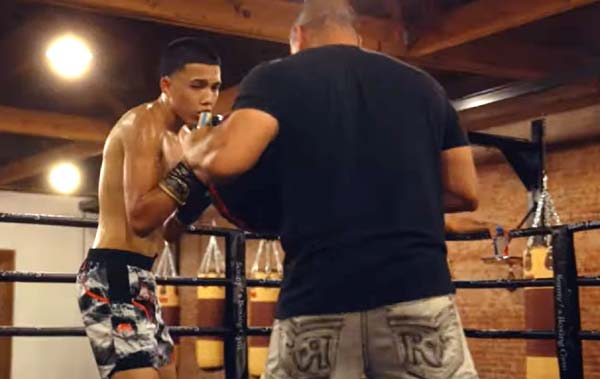To many boxing fans my age, and that means those who saw Floyd Patterson fight an eight-round main event in Brooklyn’s Eastern Parkway Arena because he wasn’t old enough to be licensed to fight ten rounds, “the Garden” can mean only one thing. Its the arena that was on 50th Street and 8th Avenue in New York City and it was the Mecca of boxing in the forties and fifties. This, of course, was decades before it was ever conceived that “big fights” would be held in casino parking lots or ballrooms and most people thought Zaire was a bakery in the Bronx that had bagels “to die for”.
Friday night was fight night at the Garden, not once a month or every other week, but every Friday, most weeks of the year. The main event started at ten o’clock, since it was televised as part of the “Gillette Cavalcade of Sports” on the NBC network. The “prelims” started at 7:30, and for the most part, these bouts were attended by large neighborhood contingents, rooting for a local fighter from one of the five boroughs of the city who had “come up through the Gloves” and the local fight clubs and had finally “made it” to the Garden. In addition to Brooklyn’s Eastern Parkway, there was Sunnyside Gardens in Queens, St Nicks Arena in Manhattan and just to the north of the city, the Westchester County Center in White Plains. These clubs had at least one boxing show a month and, in turn, funneled all of their best fighters to the hallowed ground of “the Garden”.
The bulk of the crowd on Friday night was late arriving inside the arena, usually timing it so they made it for the “semi-windup”, the bout before the main event. This was an eight or ten rounder and usually featured two experienced fighters, maybe a local boxer, maybe two out-of-towners, who were literally and figuratively, one step away from a main event in Madison Square Garden. Before going inside the arena, most of the crowd would congregate in one of two places, Mickey Walker’s “joint” (I never, in all my years going to the Garden, heard it called anything but “joint”; never a bar, a saloon or a gin mill, always “I’ll meetcha in Mickey Walker’s joint”), across 50th St. The “Toy Bulldog”, the former welterweight champion, was a “hands on” owner and was usually at the bar on fight night, meeting and greeting the fans who packed the place to overflow. The non-imbiding groups, mainly the gamblers, ticket scalpers and all manner of characters of the city would hover inside the lobby of the Garden, just in front of the turnstiles that led to the main arena. Out front of the Garden there was a theater marquee, similar to the movie theaters of the day, on which the night’s attraction was detailed in movable, black block letters “TONITE: GIARDELLO vs DURANDO 10 RDs, PRELIMS 7:30.
These two venues, Walkers “joint” and the Garden lobby both had their enticements. In Mickey Walkers, the drink prices were scaled for the average fight fan, that is the “working stiff”, whose choice of libation tended towards a shot of liquor, a draught beer or both (a combination known as a “boilermaker” and usually summoned with a cigarette tinged, raspy voice requesting “gimme a shot of Bushmills, beer back”). A bartender in Mickey Walkers really didn’t need the recipe for a Manhattan or Daquari nearby. The shots of liquor were fifty cents and the draught beer fifteen cents and like many of the favorite fighters across 50th street, they were “honest” drinks.
The Garden lobby, on fight night, on the other hand, was akin to being inside a Damon Runyon short story. Con men, cops, politicians, ex-pugs, every kind of “hanger on”, ticket scalpers, mobsters, “molls” and every manner of New York fight fan imaginable stood elbow to elbow, talking, dealing, wagering and generally passing time while the “preliminary bouts went on inside the area. Every square inch of the lobby, it seemed, was occupied by some sort of deal-making transaction, some sort of bet, some sort of boxing conversation. Two guys negotiating the “scalp” price for tickets “right up front, so close, you’ll be wiping the blood off”; in another corner, an argument about whether the odds on the night’s “main go” was 6-5 or 7-5; against another wall, two “old time” regulars telling “first hand” Joe Louis stories as they did every Friday night for as long as anyone could remember. Same wall, same “old timers”, same stories. To a kid from Brooklyn, it was thrilling, enchanting and educational all at the same time.
Not that I got to the Garden every Friday or even most Fridays. I usually went with my dad and only when someone gave him tickets. His benefactor was usually a shop steward in the subway union, part of the MTA, the Metropolitan Transportation Authority, a working destination for many of the Irish immigrants who had arrived on Ellis Island in the harbor and never got past New York City. The tickets were usually up, and I mean up, in the mezzanine. The seats were a long way from the ring. However, given the way the Garden was transformed on fight night, sitting in the mezzanine, you still had a pretty good view of action, since when once the fight started all the house lights went out and only the lights around the ring stayed on, accentuating the action in the ring. The mezzanine seats, however, were desirable since it was up there, in the cheap seats, where the “real” fight fans sat. The fans up in that section were loud, opinionated, but knowledgable; they knew boxing, and they were more than willing to share that knowledge with the guy in the next seat or the next row, whether he asked for those opinions, shared those opinions or cared to listen. It was a bit like “talk radio” is today, only “live and loud”. It was great.
I saw Rex Layne, Billy Graham (the Greenwich Village fighter not the preacher who was known as the “uncrowned welterweight champ” the result of what was universally agreed, at least in the mezzanine, was a “hometown” loss to Kid Gavilan in Havana in 1952), Johnny Bratton, Gil Turner, Roland LaStarza and I remember a great fight between Joey Giardello and Ernie Durando, two very tough guys from Pennsylvania, that I can still “see” being advertised on the Garden marquee. But the fight I remember, like no other in the Garden, or for that matter, anywhere else, was the one my dad and I saw the night we “moved down front.”.
It was October 21, 1953, four days before my birthday and my dad came home from work and announced that he had tickets to that night’s fight at the Garden. That, of course, was great news on any Friday, but this Friday was special, the main event was a fifteen rounder between Bobo Olsen and Randy Turpin for the middleweight title that Sugar Ray had recently vacated. And the best part was that, this time, it wasn’t the shop steward who had provided the free tickets, but, according to my dad, these came from one of the “big shots” in the union (in a later era such a person who would be known as a “suit”). Thus, my father explained, our seats for that Friday weren’t “up in the nosebleed section”, they were “right up front”. We didn’t realize until we got to the Garden how true that was.
Usually, when we went to our seats in the Garden, we went through the lobby, through the turnstiles and turned right once we got inside and went up a series of ramps to the upper reaches of the arena. This night, we went through the turnstiles and went straight ahead to the main floor of the Garden. It was a whole new world. Everyone on the main floor wore a coat and tie. There were women in what I thought of, at the time, as evening gowns. Naturally, several of the ushers asked to see our tickets. The ushers checked the cardboards scrupulously and then, surprisingly convinced we were in the right section, pointed towards the ring. We belonged on the main floor of the Garden on that particular Friday night. And what seats they were; ten rows from the ring (several friends told me that they had seen me on TV, but since in those days, there was no such thing as replays or video tape, I never confirmed that fact, but we were so close, I don’t doubt it). What seats, and what a fight.
Of course, the first thing you noticed, sitting ten rows from the ring, was that everything, the colors, the punches, the sounds, everything was magnified. You heard the punches land, you saw the sweat fly, you heard the fighters react when they were hit and you heard a grunt of exertion when they threw a punch. And Olsen and Turpin threw punches, for fifteen rounds, in what seemed to be a non-stop, no clinching brawl. It was amazingly simple, both fighters going for the middleweight championship and fully realizing to get it they needed to incapacitate the other, threw devasting body blows and destructive hooks to the head and amazingly kept coming at each other for the full 45 minutes, fifteen three minute rounds, each one, bell to bell action. The crowd, a sellout, seemed only to sit and catch their breath during the one minute between rounds, even the “swells” (as my dad later labelled the people sitting around us at ringside in formal evening wear). It may have been the proximity to the action, but I think the real reason that the absolute, brutal savagery of this bout has stayed with me over the years, is simply the fact that it was just non-stop, unrelenting fighting by two of the toughest fighters I have ever seen in the ring. It was the sport of boxing at its best; two great athletes, two very tough guys, engaged in sanctioned mayhem. It was savage and beautiful at the same time. It was boxing at its most brutal and at its best. The appreciative applause of the crowd started about a minute before the fight ended and continued at least thirty seconds after the final bell. Olsen, of course, won and became the new middleweight champ. But, Turpin didn’t lose, or at least it wouldn’t have been proper to call him a loser on this night; he had simply come in a very close second.
Years later, I read a story about Albert Einstein, who shortly after the second World War, was asked by a reporter what weapons would be used to fight World War III. The professor thought for a moment and then said he didn’t know, but World War IV would be fought with sticks and stones. Now, I doubt that Albert Einstein had ever been to the Friday Night fights at the Garden and I’m fairly certain he was not a huge boxing fan or that he had ever heard of Bobo Olsen or Randy Turpin. But when I read that story, my first thought was of October 21, 1953, sitting ten rows from the ring in the Garden and remembering the way Bobo Olsen and Randy Turpin fought that night and I knew exactly what the professor was talking about Bernie McCoy



